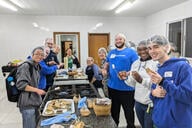You have /5 articles left.
Sign up for a free account or log in.

Disabled and Here
According to the Centers for Disease Control and Prevention, about 26 percent of people in the United States have a disability. That includes both visible disabilities, such as many mobility impairments, and hidden ones, such as psychosocial or emotional conditions.
But some research shows college students with disabilities have lower graduation and retention rates than their peers without disabilities.
In the past few years, some colleges and universities have started disability studies departments and programs. Others -- such as Syracuse University, Miami University of Ohio and the University of Illinois at Chicago -- have created disability cultural centers or affinity groups. But efforts such as those are still less than common. And although many statements from college presidents and administrations make clear they understand disability to be a part of diversity, scholars and activists say they still don't feel that higher education has accepted that disability is an axis of identity that can be celebrated.
Part of the larger problem, some activists and scholars say, is that disability is often framed as an individual biomedical condition and as a technical problem to be solved rather than as a group identity. Disability is often confined to offices that work through educational accommodations. A study of 23 California State University websites from 2012 to 2014 found that only one associated disability with diversity and inclusion.
“It’s predominantly framed as a biomedical issue or a technical one in terms of legal compliance,” said Lauren Shallish, a professor of special education, language and literacy at the College of New Jersey. “That framing forecloses any other discussion or experience or identity or social power.”
Shallish’s research and interviews with university leaders have found the “medicalized” framing of disability to be very prevalent in higher education.
“What I find is with diversity in higher ed, it’s all very selectively inclusive,” said Syreeta Nolan, a senior at the University of California, San Diego, and co-founder of Disability in Higher Ed. “The Black resource center is inclusive for Black people, the women’s center is inclusive for women, the LGBTQ resource is inclusive for those who are LGBTQ themselves. But I don’t see that intersectionality and I feel really weird and off when I try to talk about disability in those spaces.”
Nolan's university's Strategic Plan for Inclusive Excellence does include people with disabilities, but looking at videos the university has created about the plan, she said, she doesn’t see students or faculty with disabilities represented. She has participated in undergraduate research programs for historically underrepresented students, but those have been open to her because she is Black, not because she is disabled.
Though many colleges are engaging in much-needed efforts to diversify their faculty and student bodies, fewer are engaged in efforts to recruit and retain faculty and students with disabilities.
“If diversity actually valued disability, I could have people to look up to as a disabled undergraduate,” said Nolan. “There would be such a world change if diversity included disability enough that there was more than 3.6 percent of tenured faculty that consider themselves disabled.”
When disability is discussed in higher ed, it’s often talked about in the context of educational accommodations that are required by law and allow students with disabilities to participate in class. Though accommodations are important and many activists and scholars are looking to improve the accommodation process, that focus can be limited, some say.
“Being a disabled student, I’m not just a disabled student in the classroom,” Nolan said.
Though a human resources webpage at her university makes clear that the administration believes diversity includes disability, the content of public-facing sites at UCSD focuses almost exclusively on accommodations and accessibility, rather than disability as an identity.
Shallish, whose research has involved interviewing students with disabilities about their accommodations, said many are more concerned about other aspects of their college experience than about accommodations.
“[They said,] ‘My real question is, does my roommate need to know I’m bipolar?’ Or ‘does my soccer team need to know I have a learning disability?’” she said.
A focus on educational accommodations can leave out an understanding of other barriers students with disabilities may face, said Harry Paul, an M.D.-Ph.D. student at Johns Hopkins University and communications director for the Alliance of Disabilities and Chronic Illnesses in Medicine.
“Accommodations are usually only available to people who have the means to get testing, to get some kind of doctor’s note. Accommodations do not often take care of accommodating people off campus,” he said. “You can have someone to help you get to class, but if you can’t get your groceries, how can you stay in school?”
Many efforts to recruit or include students with disabilities could be easy, Paul said. Offices for diversity and inclusion could incorporate efforts at improving campus climate for students with disabilities. Administrations could hold listening sessions with disabled students and carry out their recommendations. They could bring disability scholars to talk on campus or add Braille to dining hall menus.
“If you recruit disabled students, are they going to feel like their disability is a burden that the school is complying with as it’s the law?” he said. “Or are they going to feel like they are valued for their perspective?”
At UCSD, which Nolan attends, officials said disability is included in commitments to inclusivity, and the university is dedicated to moving beyond simple compliance with the law. "Compliance is the minimum," said Becky Petitt, vice chancellor for equity, diversity and inclusion at UCSD, via email. "Our commitment to scholars and professionals with disabilities involves intentionally facilitating access, active recruitment, thoughtful representation and engagement throughout all areas of university life, and the creation of accountability structures to ensure that we are faithful to our vision of being an institution where all students, faculty, and staff can thrive."
California State University, despite the 2014 study results suggesting that only one campus associated disability with diversity, has said that it does include disability in its programming.
"Efforts to advance diversity, equity and inclusion are definitely inclusive of a wide range of identities, including disability and its intersection with gender, race and ethnicity," said Luoluo Hong, associate vice chancellor for student affairs and enrollment management at Cal State, via email. "We are also dedicated to increasing educational access and accessibility for students with disabilities -- a responsibility which has been made especially salient during our current context, in which instruction on our campuses is predominantly online, remote or virtual. By policy and by practice, the CSU has dedicated time and resources to increase and improve the use of accessible technology. Finally, allegations of discrimination on the basis of disability are taken seriously and fully investigated."
Due for a Reckoning
For some scholars and activists, a shift in higher ed would require greater societal changes and acknowledgment of the intersections between disability and other identities. The disabled community is not a monolith, and how people experience a disability is filtered through their race and other characteristics, and vice versa. For example, both Black and disabled individuals are overrepresented among victims of police killings, creating unique implications for people who are both Black and disabled.
"What I would like to see is a fuller integration and examination of the intersectionality between race and disability. I think diversity is missing an entire aspect when the intersectionality of race and disability is ignored,” said Denise Reid, a professor of education at Biola University and co-author of the study on Cal State.
Reid said some universities are making progress. Her university has made a deliberate effort to include disability in statements and conversations about diversity, she said, and has started conversations with faculty about the classroom experience.
But she’s not sure that any effort in higher education to fully acknowledge the intersections between race, ethnicity and disability will be realized in her lifetime.
“We continue to investigate issues of race and ethnicity,” she said. “However, I am hopeful that at some point the intersectionality of race and disability would just be part of the diversity conversation.”
Shallish said that while she believes affinity groups and discussion would be beneficial for higher education, the issue runs deeper.
“Colleges and universities really need to reckon with their own entrenched history around ability supremacy. They’ve always prioritized the quote normal body or quote normal mind,” she said. “Higher ed is defined by who it excludes.”
Disability is often closely associated with the criminal justice system and racism, she said, as children of color are overrepresented in special education classes and often are pushed into juvenile justice programs. Colleges could do more work around abolishing current systems of incarceration and punishment.
“Higher ed could really do this work,” she added. “So then it comes down to choice. Are you going to choose to do it or not?”




